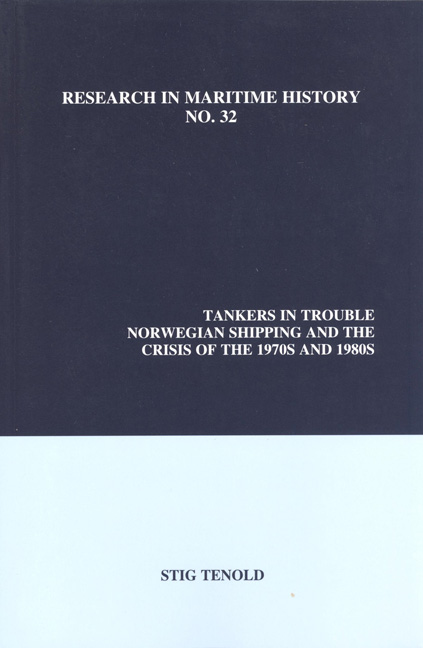Book contents
- Frontmatter
- Table of Contents
- List of Tables in the Text
- List of Illustrations
- Preface
- Chapter 1 Introduction
- Chapter 2 The Shipping Market after World War II
- Chapter 3 The Basis of the Tanker Crisis
- Chapter 4 The Contagion and Short-term Effects of the Crisis
- Chapter 5 Stage Two of the Crisis and the Long-term Changes
- Chapter 6 The Basis for the Crisis in Norwegian Shipping
- Chapter 7 Structural Transformations in Norwegian Shipping
- Chapter 8 The Fates of Four Norwegian Shipowners
- Chapter 9 Conclusion
- Appendices
- Bibliography: Select Bibliography
Chapter 2 - The Shipping Market after World War II
- Frontmatter
- Table of Contents
- List of Tables in the Text
- List of Illustrations
- Preface
- Chapter 1 Introduction
- Chapter 2 The Shipping Market after World War II
- Chapter 3 The Basis of the Tanker Crisis
- Chapter 4 The Contagion and Short-term Effects of the Crisis
- Chapter 5 Stage Two of the Crisis and the Long-term Changes
- Chapter 6 The Basis for the Crisis in Norwegian Shipping
- Chapter 7 Structural Transformations in Norwegian Shipping
- Chapter 8 The Fates of Four Norwegian Shipowners
- Chapter 9 Conclusion
- Appendices
- Bibliography: Select Bibliography
Summary
Shipping and shipbuilding underwent a series of major changes in the first decades after World War II. Growth in world trade, with corresponding increases in the demand for shipping services and technological improvements, laid the foundation for a drastic transformation of the shipping market. The movement towards increased globalisation that began in the nineteenth century was interrupted in the internar period. Seaborne trade increased only slightly, and it was primarily the rapid growth in the petroleum trade that prevented an overall reduction. During most of the 1930s the world fleet declined due to the scrapping of obsolete tonnage and limited reinvestment. But growth resumed after 1945, and technological innovations in shipping and shipbuilding enabled shipowners to benefit from the improved conditions.
Strong growth and structural changes paved the way for the transformation of the world fleet. Both its structure and the vessels themselves reflected growth and new opportunities. One prominent shift was the increasing significance of the oil trade, with liquid bulk transports becoming the dominant segment of the shipping industry. Moreover, the period from 1950 to the early 1970s was marked by the first stage of the containerisation of the liner trades and the breakthrough of bulk shipping into a number of new cargoes. The result was increased specialisation and reduced linkages between the various shipping sectors. The maritime economist Martin Stopford has written that:
[i]n 1945 the world merchant fleet consisted of passenger ships, liners, tramps and a small number of tankers. Few vessels used for cargo transport were larger than 20,000 dwt. By 1975 the fleet had changed out of all recognition and all the major trades had been taken over by specialized ships.
The demand for transport services is closely related to the level of world trade. The first quarter-century after the end of the World War II was characterised by strong growth in international trade. Economic growth was strong in most Western nations in the initial decades after 1945. Yet a characteristic feature of international economic development was that world trade grew even faster than production. While global production trebled from 1953 to 1973, the volume of international trade grew by 350 percent.
- Type
- Chapter
- Information
- Tankers in TroubleNorwegian Shipping and the Crisis of the 1970s and 1980s, pp. 7 - 16Publisher: Liverpool University PressPrint publication year: 2006

